Numerical Simulation of Crack Propagation in Flexible Asphalt Pavements Based on Cohesive Zone Model Developed from Asphalt Mixtures
Abstract
1. Introduction
2. Experimental Preparation
2.1. Material Design
2.2. Constitute Law for Fracture Behavior
2.3. Static Three-Point Semi-Circular Bend Test
2.4. Dynamic Three-Point Semi-Circular Bend Test
3. Numerical Simulation of Crack Propagation in Static 3PSCBT
3.1. Construction of the FE Model for Static 3PSCBT
3.2. Verification of the FE model for static 3PSCBT
4. Numerical Simulation of Crack Propagation in Pavement Structure
4.1. Construction of the FE Model for the Pavement Structure
4.2. Simulation of Crack Propagation in Pavement Structure
5. Prediction of Load Cycles to the Failure of the Asphalt Pavement Structure
- Fracture energy for dynamic 3PSCBT at failure (mJ) (in the laboratory),
- Fracture energy for static 3PSCBT at failure (mJ) (in the simulation).
6. Conclusions and Outlook
Author Contributions
Funding
Conflicts of Interest
References
- Zienkiewicz, O.C.; Taylor, R.L. The Finite Element Method: Its Basis and Fundamentals, 5th ed.; Elsevier Butterworth-Heinemann: Oxford, UK, 2000; Volume 1, pp. 468–492. [Google Scholar]
- Scarpas, A. CAPA-3D: A Mechanics Based Computational Platform for Pavement Engineering. Ph.D. Thesis, TU Delft, Delft, The Netherlands, 21 February 2005. [Google Scholar]
- Liu, P.; Xing, Q.; Wang, D.; Oeser, M. Application of dynamic analysis in semi-analytical finite element method. Materials 2017, 10, 1010. [Google Scholar] [CrossRef] [PubMed]
- Wang, H.; Al-Qadi, I.L. Near-Surface Pavement Failure under Multiaxial Stress State in Thick Asphalt Pavement. Transp. Res. Rec.—Transp. Res. Board 2010, 2154, 91–99. [Google Scholar] [CrossRef]
- Liu, P.; Xing, Q.; Wang, D.; Oeser, M. Application of linear viscoelastic properties in semianalytical finite element method with recursive time integration to analyze asphalt pavement structure. Adv. Civ. Eng. 2018. [Google Scholar] [CrossRef]
- Yin, A.; Yang, X.; Gao, H.; Zhu, H. Tensile fracture simulation of random heterogeneous asphalt mixture with cohesive crack model. Eng. Fract. Mech. 2012, 92, 40–55. [Google Scholar] [CrossRef]
- Liu, P.; Wang, D.; Oeser, M. Application of semi-analytical finite element method to analyze asphalt pavement response under heavy traffic loads. J. Traffic Transp. Eng. (Engl. Ed.) 2017, 4, 206–214. [Google Scholar] [CrossRef]
- Liu, P.; Xing, Q.; Dong, Y.; Wang, D.; Oeser, M.; Yuan, S. Application of finite layer method in pavement structural analysis. Appl. Sci. 2017, 7, 611. [Google Scholar] [CrossRef]
- Kim, H.; Buttlar, W.G. Discrete fracture modeling of asphalt concrete. Int. J. Solids Struct. 2009, 46, 2593–2604. [Google Scholar] [CrossRef]
- Liu, P.; Wang, D.; Hu, J.; Oeser, M. SAFEM-Software with graphical user interface for fast and accurate finite element analysis of asphalt pavements. J. Test. Eval. 2016, 45, 1301–1315. [Google Scholar] [CrossRef]
- Gross, D.; Seelig, T. Bruchmechanik: Mit einer Einführung in die Mikromechanik; Springer: Berlin, Germany, 2006. [Google Scholar]
- Anderson, T.L. Fracture Mechanics: Fundamentals and Applications; CRC Press: Boca Raton, FL, USA, 2017. [Google Scholar]
- Barenblatt, G.I. The formation of equilibrium cracks during brittle fracture. General ideas and hypotheses. Axially-symmetric cracks. J. Appl. Math. Mech. 1959, 23, 622–636. [Google Scholar] [CrossRef]
- Romeo, A.; Ballarini, R. A Cohesive Zone Model for Cracks Terminating at a Bimaterial Interface. Int. J. Solids Struct. 1997, 34, 1307–1326. [Google Scholar] [CrossRef]
- Wagoner, M.P.; Buttlar, W.G.; Paulino, G.H. Disk-shaped compact tension test for asphalt concrete fracture. Exp. Mech. 2005, 45, 270–277. [Google Scholar] [CrossRef]
- Song, S.H. Fracture of Asphalt Concrete: A Cohesive Zone Modeling Approach Considering Viscoelastic Effects. Ph.D. Thesis, University of Illinois, Urbana-Champaign, IL, USA, 25 July 2006. [Google Scholar]
- Song, S.H.; Paulino, G.H.; Buttlar, W.G. Simulation of Crack Propagation in Asphalt Concrete Using an Intrinsic Cohesive Zone Model. J. Eng. Mech. 2006, 132, 1215–1223. [Google Scholar] [CrossRef]
- Liu, P.; Hu, J.; Wang, D.; Oeser, M.; Alber, S.; Ressel, W.; Falla, G.C. Modelling and evaluation of aggregate morphology on asphalt compression behavior. Constr. Build. Mater. 2017, 133, 196–208. [Google Scholar] [CrossRef]
- Xu, X.P.; Needleman, A. Numerical simulations of fast crack growth in brittle solids. J. Mech. Phys. Solids 1994, 42, 1397–1434. [Google Scholar] [CrossRef]
- Soares, J.B.; Colares de Freitas, F.A.; Allen, D.H. Crack modeling of asphaltic mixtures considering heterogeneity of the material. In Proceedings of the 82nd Annual Meeting of the Transportation Research Board (CD-ROM) 2003, Transportation Research Board, Washington, DC, USA, 12–16 January 2003. [Google Scholar]
- Paulino, G.H.; Song, S.H.; Buttlar, W.G. Cohesive zone modeling of fracture in asphalt concrete. In Proceedings of the 5th International RILEM Conference–Cracking in Pavements: Mitigation, Risk Assessment, and Preservation 2004, Limoges, France, 5–8 May 2004; pp. 63–70. [Google Scholar]
- Song, S.H.; Paulino, G.H.; Buttlar, W.G. Simulation of mode I and mixed-mode crack propagation in asphalt concrete using a bilinear cohesive zone model. In Proceedings of the 84th Annual Meeting of the Transportation Research Board (CD-ROM) 2005, Transportation Research Board, Washington, DC, USA, 9–13 January 2005. [Google Scholar]
- Baek, J.; Al-Qadi, I.L. Finite element method modeling of reflective cracking initiation and propagation: Investigation of the effect of steel reinforcement interlayer on retarding reflective cracking in hot-mix asphalt overlay. Transp. Res. Rec. 2006, 1949, 32–42. [Google Scholar] [CrossRef]
- Baek, J.; Al-Qadi, I.L. Finite element modeling of reflective cracking under moving vehicular loading: Investigation of the mechanism of reflective cracking in hot-mix asphalt overlays reinforced with interlayer systems. In Proceedings of the ASCE’s 2008 Airport and Highway Pavements Conference 2008, Bellevue, WA, USA, 15–18 October 2008; pp. 74–85. [Google Scholar]
- Kim, Y.R.; Allen, M.; Little, D.N. Computational constitutive model for predicting nonlinear viscoelastic damage and fracture failure of asphalt concrete mixtures. Int. J. Geomech. 2007, 7, 102–110. [Google Scholar] [CrossRef]
- Wagoner, M.P. Fracture Test for Bituminous-Aggregate Mixtures: Laboratory and Field Investigation. Ph.D. Dissertation, University of Illinois, Urbana-Champaign, IL, USA, 2006. [Google Scholar]
- Song, S.H.; Wagoner, M.P.; Paulino, G.H.; Buttlar, W.G. δ25 Crack opening displacement parameter in cohesive zone models: Experiments and simulations in asphalt concrete. Fatigue Fract. Eng. Mater. Struct. 2008, 31, 841–928. [Google Scholar] [CrossRef]
- Wang, H.; Wang, J.; Chen, J.Q. Micromechanical Analysis of Asphalt Mixture Fracture with Adhesive and Cohesive Failure. Eng. Fract. Mech. 2014, 132, 104–119. [Google Scholar] [CrossRef]
- Liu, P.; Xu, H.; Wang, D.; Wang, C.; Schulze, C.; Oeser, M. Comparison of mechanical responses of asphalt mixtures manufactured by different compaction methods. Constr. Build. Mater. 2018, 162, 765–780. [Google Scholar] [CrossRef]
- Hu, J.; Liu, P.; Wang, D.; Oeser, M.; Canon Falla, G. Investigation on interface stripping damage at high-temperature using microstructural analysis. Int. J. Pavement Eng. 2017, 1, 1–13. [Google Scholar] [CrossRef]
- Yin, A.; Yang, X.; Yang, Z. 2D and 3D fracture modeling of asphalt mixture with randomly distributed aggregates and embedded cohesive cracks. Procedia Iutam 2013, 6, 114–122. [Google Scholar] [CrossRef]
- Yin, A.; Yang, X.; Zeng, G.; Gao, H. Fracture simulation of pre-cracked heterogeneous asphalt mixture beam with movable three-point bending load. Constr. Build. Mater. 2014, 65, 232–242. [Google Scholar] [CrossRef]
- Yin, A.; Yang, X.; Zeng, G.; Gao, H. Experimental and numerical investigation of fracture behavior of asphalt mixture under direct shear loading. Constr. Build. Mater. 2015, 86, 21–32. [Google Scholar] [CrossRef]
- Souza, L.T.; Kim, Y.R.; Souza, F.V.; Castro, L.S. Experimental testing and finite-element modeling to evaluate the effects of aggregate angularity on bituminous mixture performance. J. Mater. Civ. Eng. 2012, 24, 249–258. [Google Scholar] [CrossRef]
- Baek, J. Modeling Reflective Cracking Development in Hot-Mix Asphalt Overlays and Quantification of Control Techniques. Ph.D. Thesis, University of Illinois, Urbana-Champaign, IL, USA, 19 May 2010. [Google Scholar]
- Bituminous Mixtures—Test Method for Hot Mix Asphalt-Part 44: Crack Propagation by Semi-Circular Bending Test; Beuth Verlag: Berlin, Germany, 2014; DIN EN 12697-44.
- Hu, J.; Liu, P.; Wang, D.; Oeser, M. Influence of aggregates’ spatial characteristics on air-voids in asphalt mixture. Int. J. Mater. Pavement Des. 2018, 19, 837–855. [Google Scholar] [CrossRef]
- Li, J.; Zhang, J.; Qian, G.; Zheng, J.; Zhang, Y. Three-dimensional simulation of aggregate and asphalt mixture using parameterized shape and size gradation. J. Mater. Civ. Eng. 2019, 31, 04019004. [Google Scholar] [CrossRef]
- Liu, P.; Otto, F.; Wang, D.; Oeser, M.; Balck, H. Measurement and evaluation on deterioration of asphalt pavements by geophones. Measurement 2017, 109, 223–232. [Google Scholar] [CrossRef]
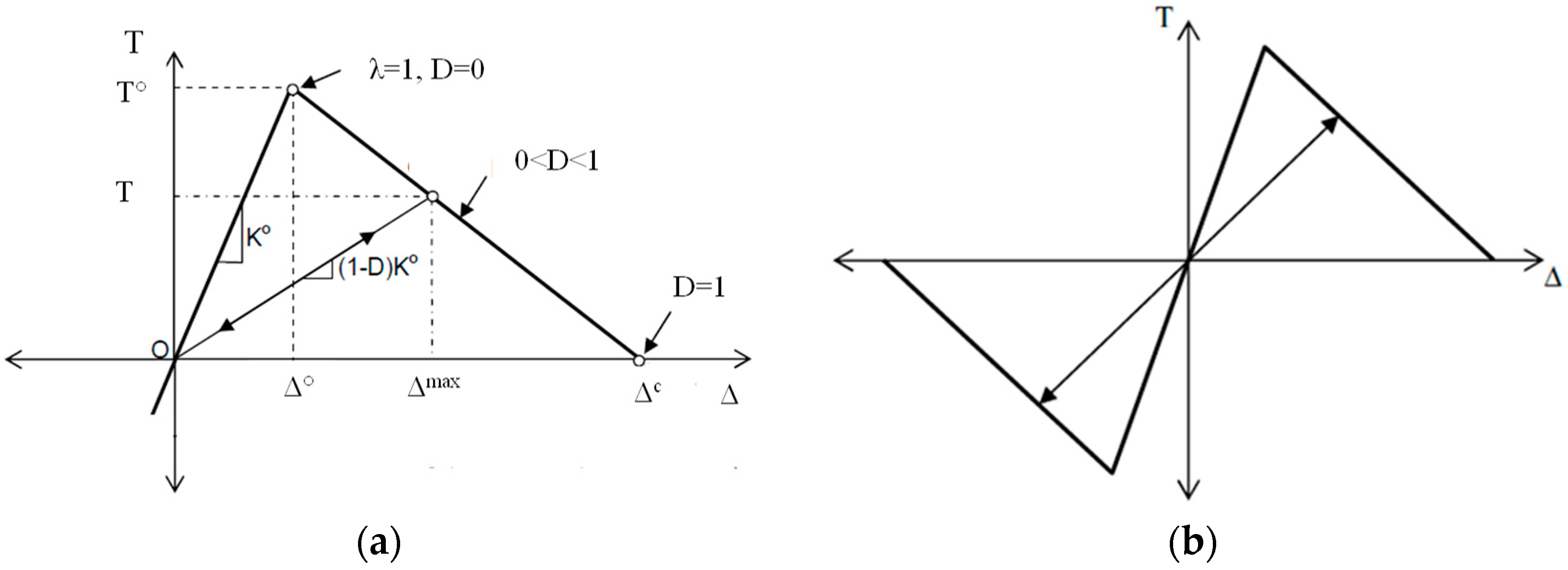
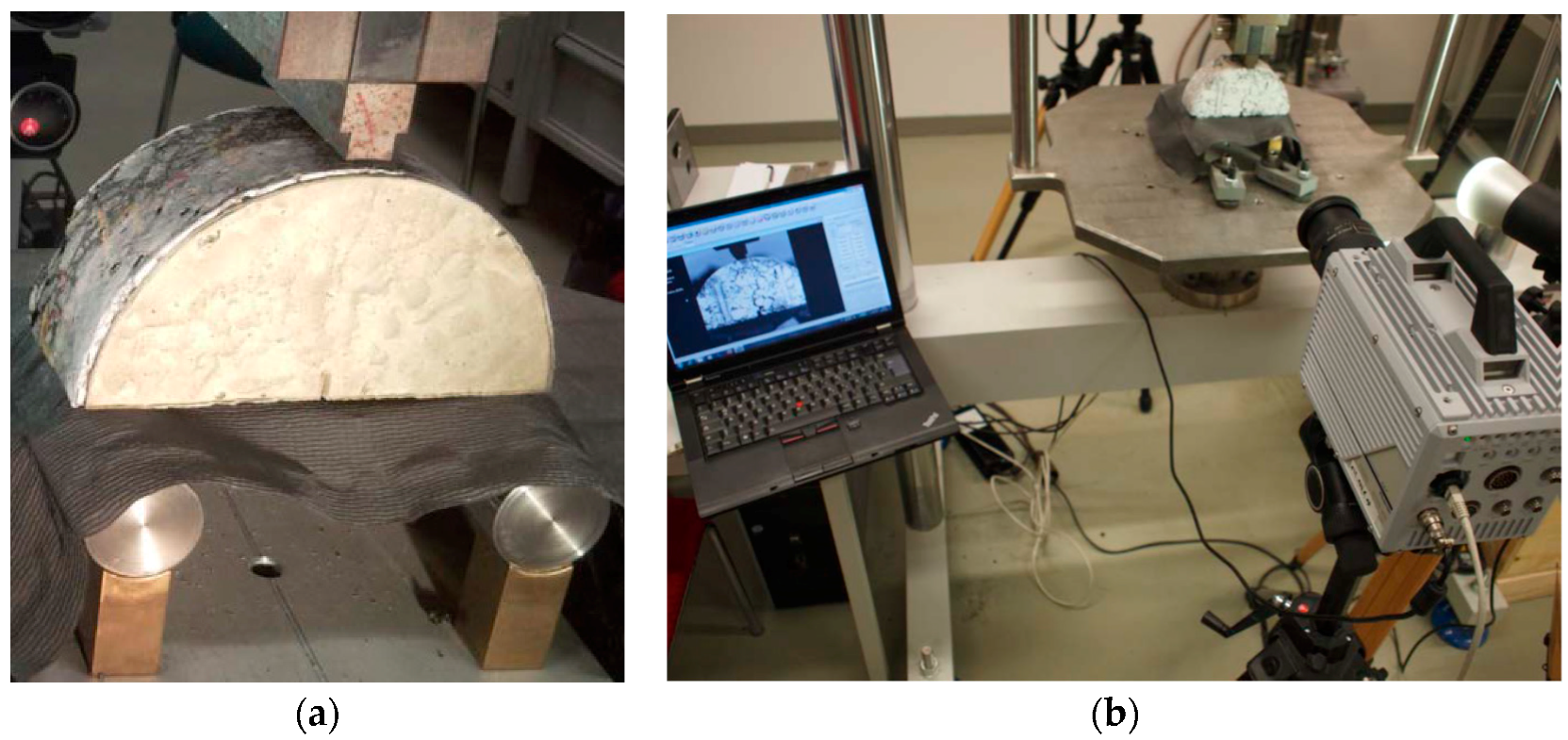
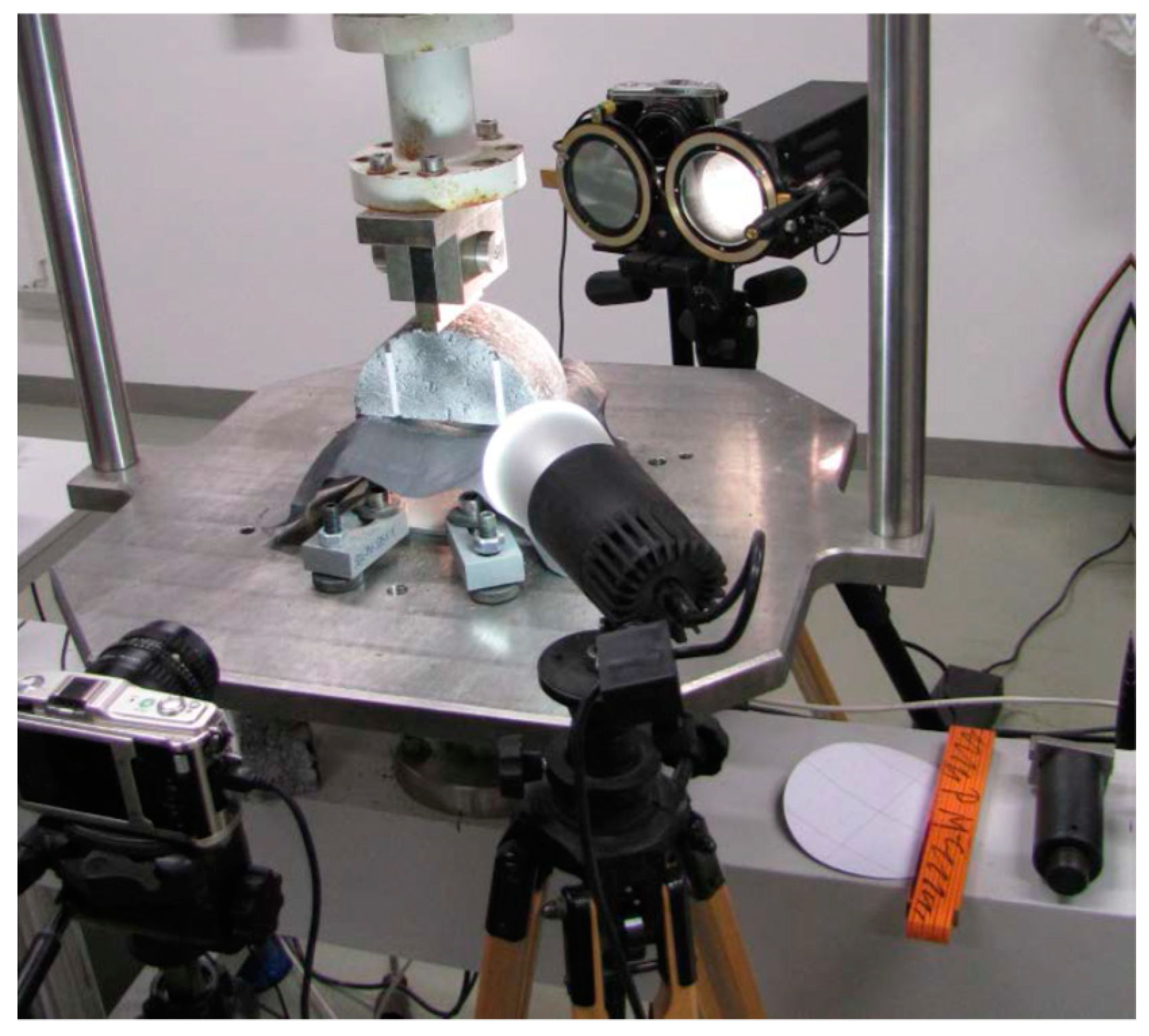
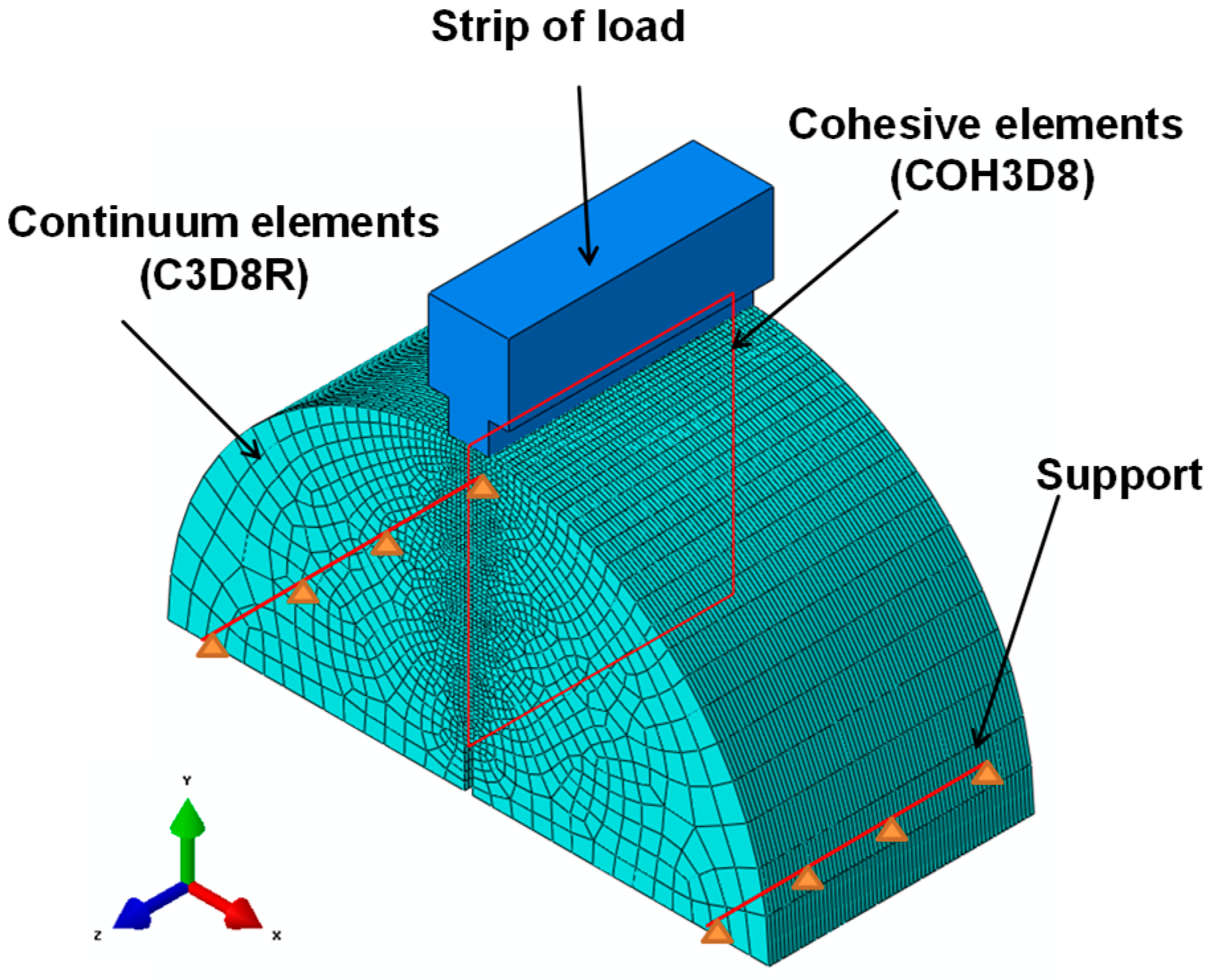
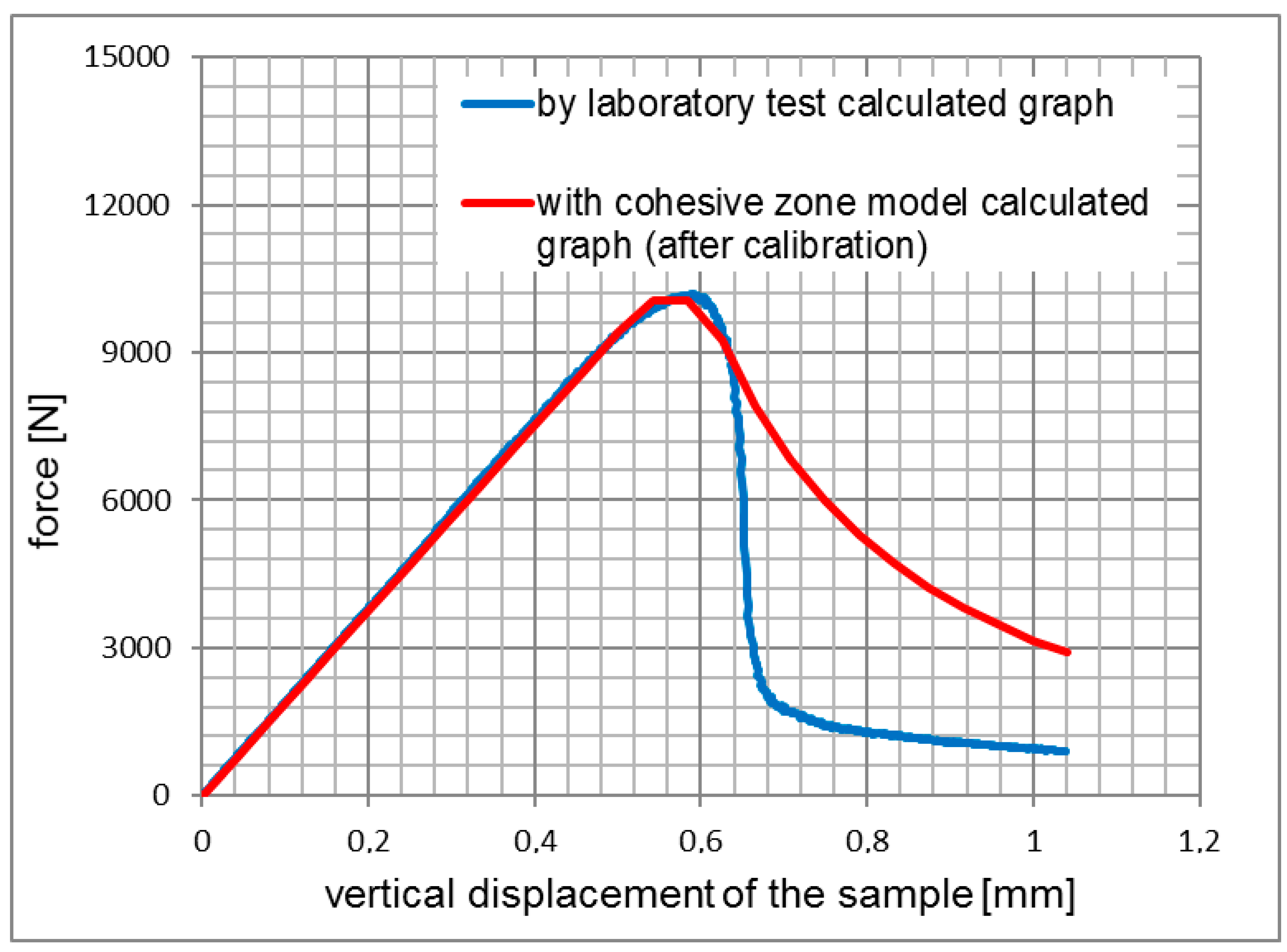
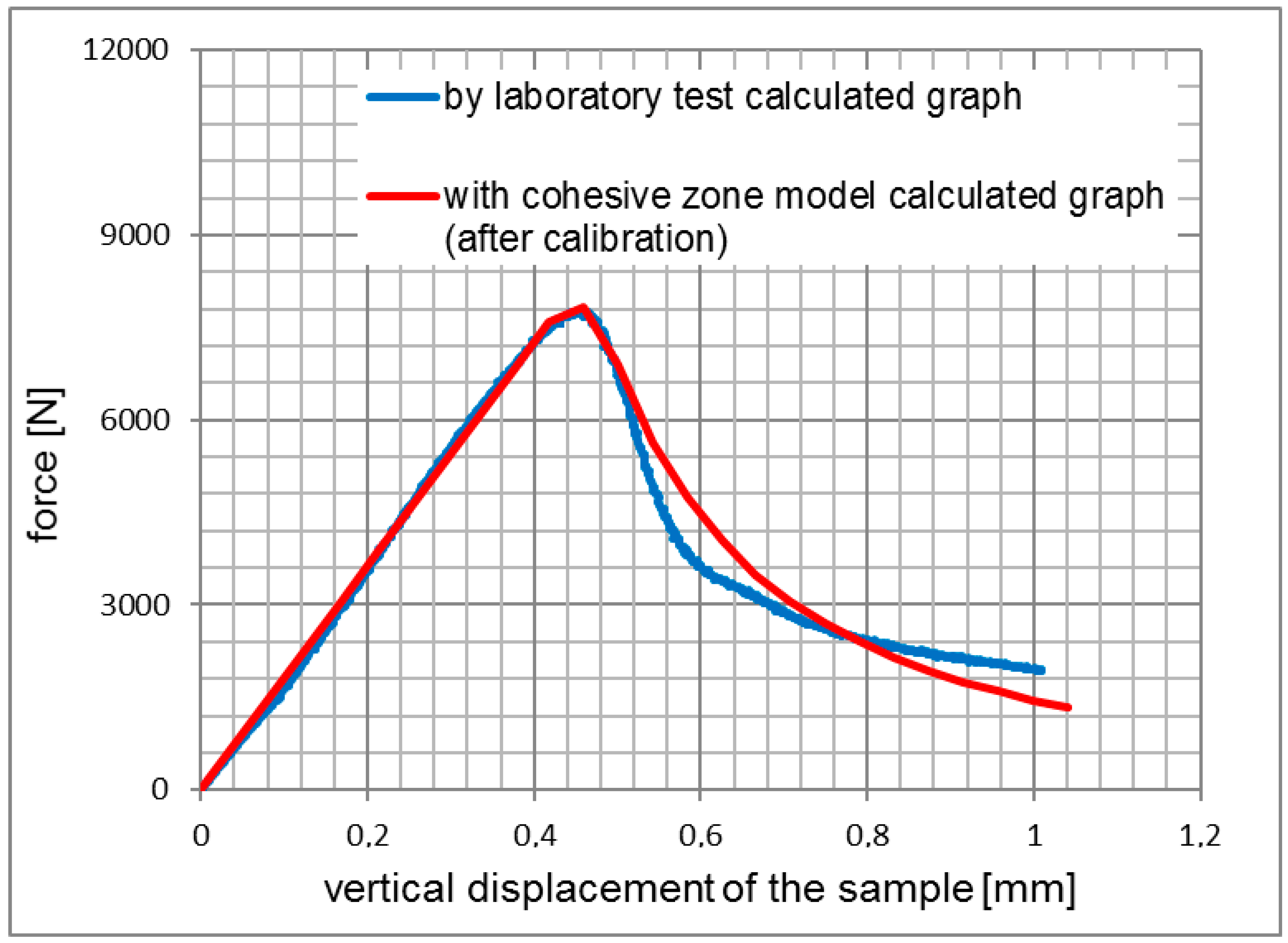
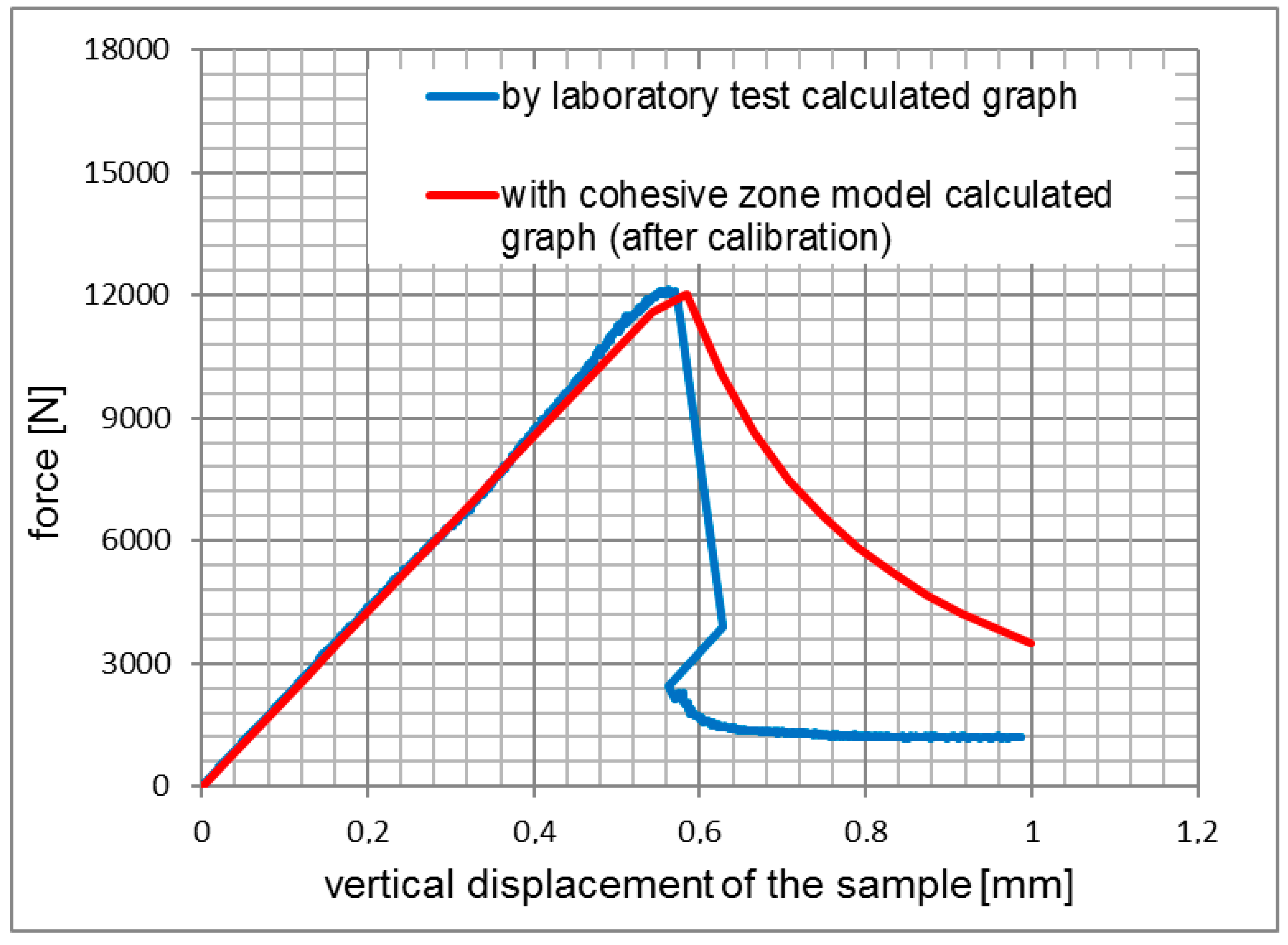

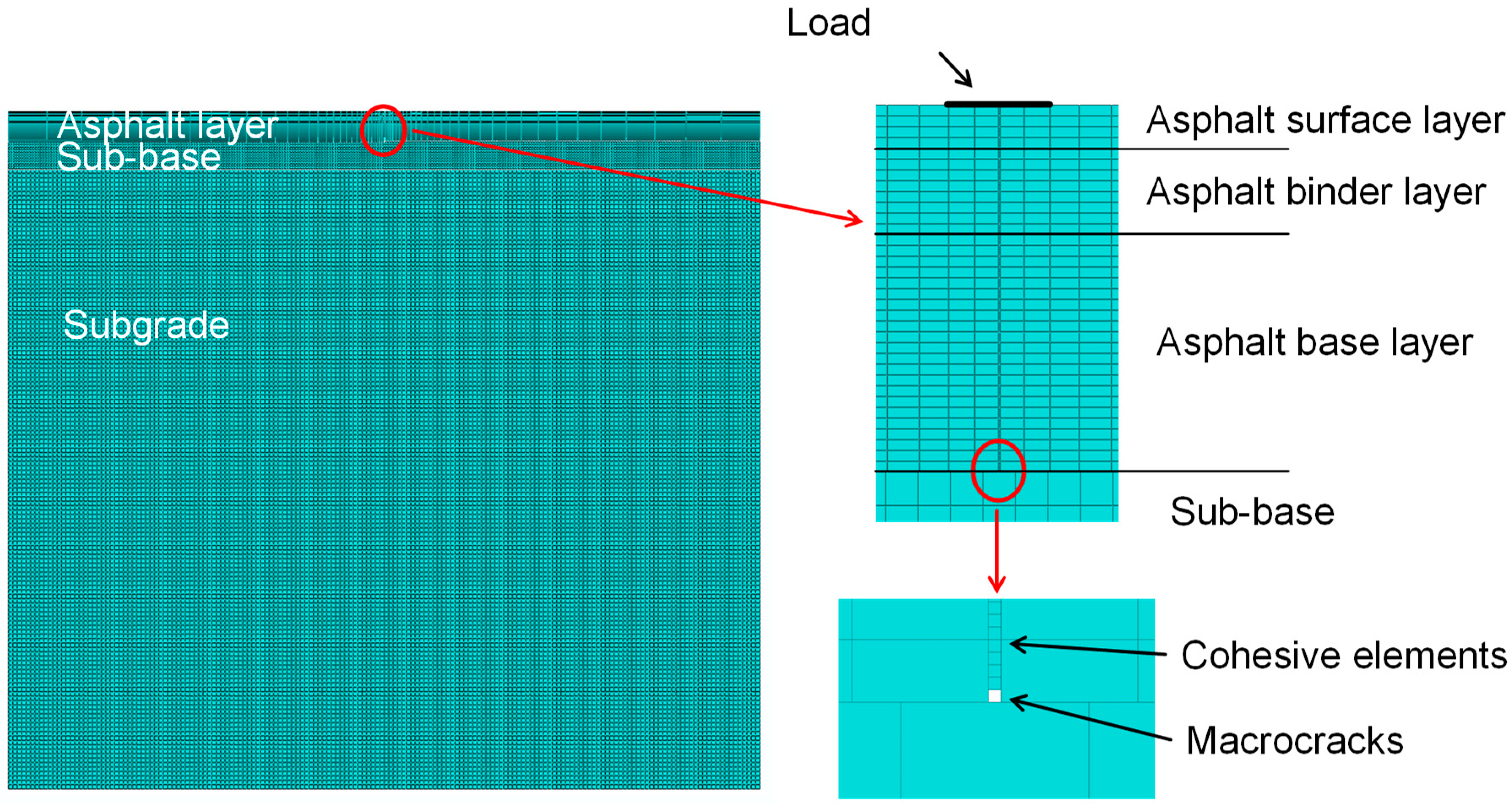
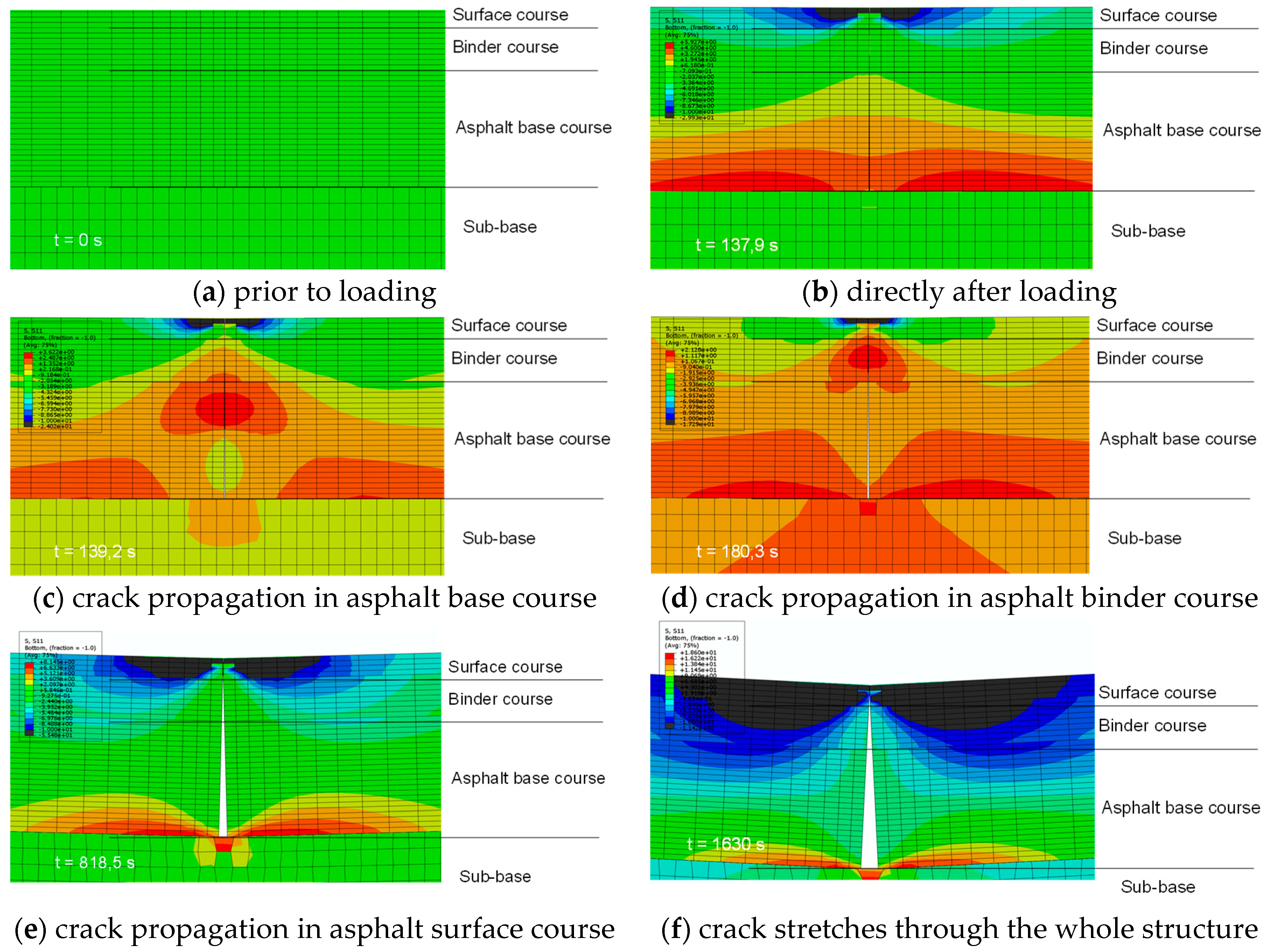
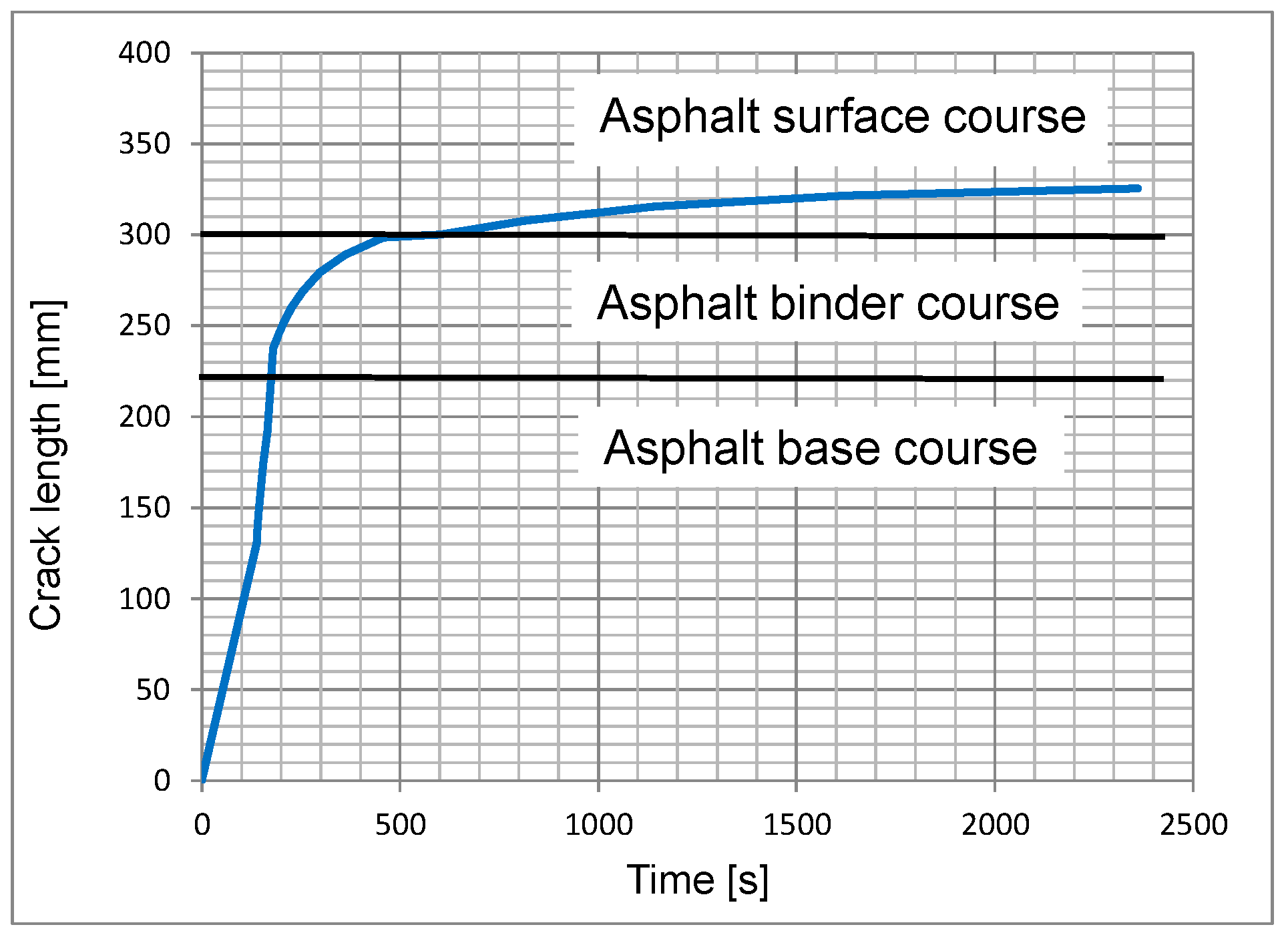
| Characteristic | Asphalt Type | ||
|---|---|---|---|
| AC 22 TS | AC 16 BS | AC 8 DS | |
| Bitumen content (M.-%) | 4.1 | 4.5 | 6.2 |
| Aggregate | Gabbro | Granodiorite | Granodiorite |
| >0.063 mm | 7 | 6 | 11 |
| 0.063–2.0 mm | 26 | 18 | 28 |
| 2.0–5.6 mm | 20 | 16 | 32 |
| 5.6–8.0 mm | 12 | 17 | 27 |
| 8.0–11.2 mm | 10 | 19 | 2 |
| 11.2–16.0 mm | 10 | 24 | - |
| 16.0–22.4 mm | 15 | - | - |
| Bulk density (g/cm3) | 2.539 | 2.366 | 2.420 |
| Density (g/cm3) | 2.695 | 2.557 | 2.499 |
| Void content (%) | 5.8 | 7.5 | 3.2 |
| Asphalt Type | Modulus of Elasticity E (MPa) | Poisson’s Ratio ν (-) | Maximum Cohesive Strength T° (MPa) | Fracture Energy Density Gc (mJ/mm2) | Stiffness K° for Cohesive Elements (MPa/mm) |
|---|---|---|---|---|---|
| Asphalt surface layer (AC 8 DS) | 15,743 | 0.30 | 3.45 | 2.00 | 3.85 |
| Asphalt binder layer (AC 16 BS) | 14,155 | 0.30 | 2.70 | 1.20 | 3.80 |
| Asphalt base layer (AC 22 TS) | 20,676 | 0.30 | 4.25 | 2.25 | 4.20 |
| Asphalt Type | Lower Stress (MPa) | Upper Stress (MPa) |
|---|---|---|
| Asphalt surface layer (AC 8 DS) | 0.1 | 2.4 |
| Asphalt binder layer (AC 16 BS) | 0.1 | 2.2 |
| Asphalt base layer (AC 22 TS) | 0.1 | 2.9 |
| Thickness (mm) | Young’s Modulus E (MPa) | Poisson’s Ratio ν (-) | Maximum Cohesive Strength T° (MPa) | Fracture Energy Density Gc (mJ/mm2) | Stiffness K° for The Cohesive Elements (MPa/mm) | |
|---|---|---|---|---|---|---|
| Asphalt surface layer | 40 | 15,743 | 0.30 | 3.45 | 2.00 | 3.85 |
| Asphalt binder layer | 80 | 14,155 | 0.30 | 2.70 | 1.20 | 3.80 |
| Asphalt base layer | 220 | 20,676 | 0.30 | 4.25 | 2.25 | 4.20 |
| Sub-base | 310 | 100 | 0.49 | - | - | - |
| Subgrade | 7000 | 45 | 0.49 | - | - | - |
| Fracture Energy from the Dynamic 3PSCBT (mJ) | Fracture Energy from the Numerical Simulation (mJ) | Calibration Factor CF (-) | |
|---|---|---|---|
| Asphalt surface layer | 8994 | 6862 | 1.31 |
| Asphalt binder layer | 5405 | 4350 | 1.24 |
| Asphalt base layer | 9207 | 7720 | 1.19 |
| Asphalt Layer | (mJ) | (-) | (mJ) | (-) |
|---|---|---|---|---|
| Asphalt surface layer | 8994 | 12,885 | 4200 | 7882 |
| Asphalt binder layer | 5405 | 4469 | 13,500 | 13,841 |
| Asphalt base layer | 9207 | 10,550 | 19,590 | 26,712 |
© 2019 by the authors. Licensee MDPI, Basel, Switzerland. This article is an open access article distributed under the terms and conditions of the Creative Commons Attribution (CC BY) license (http://creativecommons.org/licenses/by/4.0/).
Share and Cite
Liu, P.; Chen, J.; Lu, G.; Wang, D.; Oeser, M.; Leischner, S. Numerical Simulation of Crack Propagation in Flexible Asphalt Pavements Based on Cohesive Zone Model Developed from Asphalt Mixtures. Materials 2019, 12, 1278. https://doi.org/10.3390/ma12081278
Liu P, Chen J, Lu G, Wang D, Oeser M, Leischner S. Numerical Simulation of Crack Propagation in Flexible Asphalt Pavements Based on Cohesive Zone Model Developed from Asphalt Mixtures. Materials. 2019; 12(8):1278. https://doi.org/10.3390/ma12081278
Chicago/Turabian StyleLiu, Pengfei, Jian Chen, Guoyang Lu, Dawei Wang, Markus Oeser, and Sabine Leischner. 2019. "Numerical Simulation of Crack Propagation in Flexible Asphalt Pavements Based on Cohesive Zone Model Developed from Asphalt Mixtures" Materials 12, no. 8: 1278. https://doi.org/10.3390/ma12081278
APA StyleLiu, P., Chen, J., Lu, G., Wang, D., Oeser, M., & Leischner, S. (2019). Numerical Simulation of Crack Propagation in Flexible Asphalt Pavements Based on Cohesive Zone Model Developed from Asphalt Mixtures. Materials, 12(8), 1278. https://doi.org/10.3390/ma12081278








